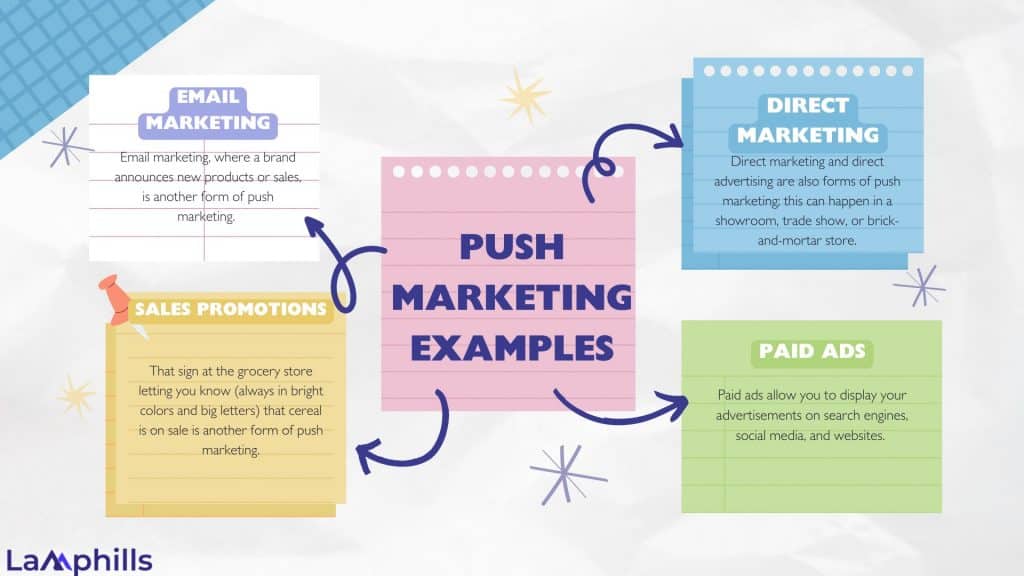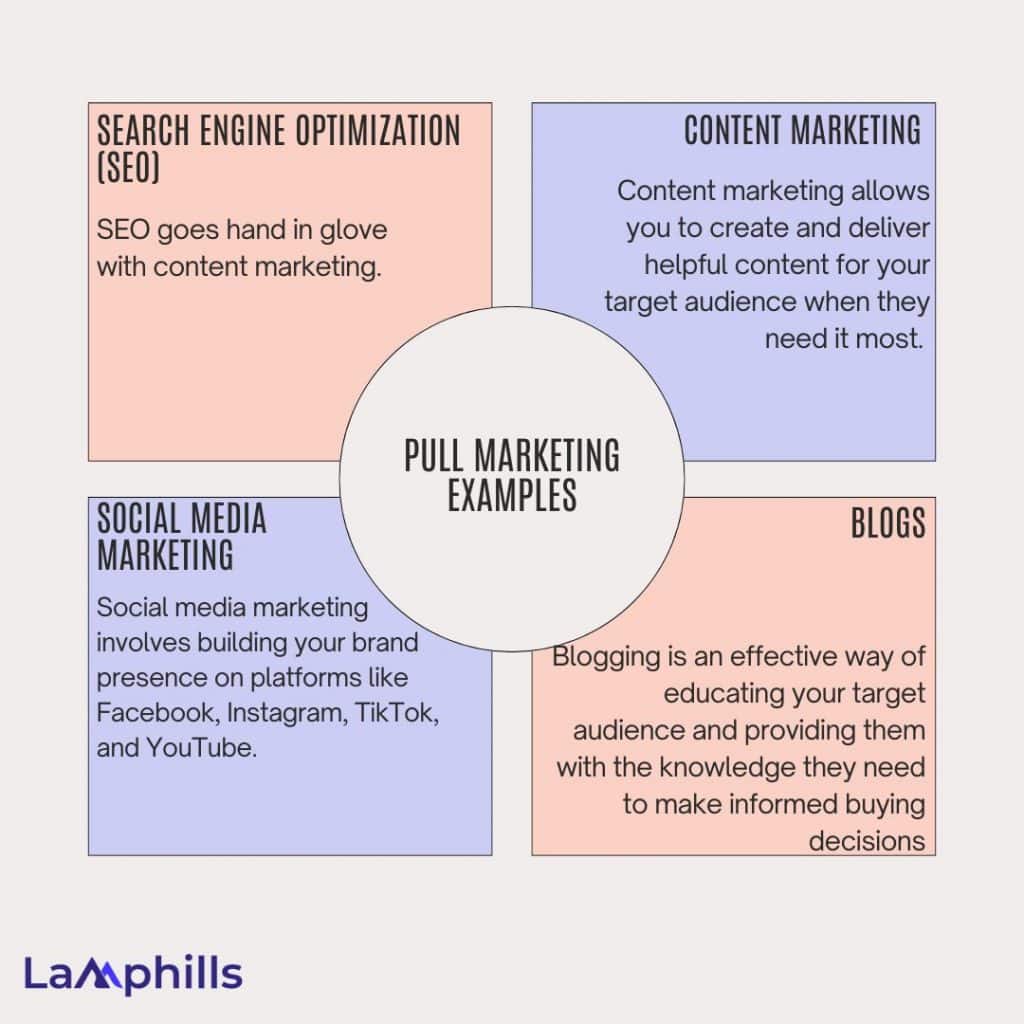Timing and strategy are key components of customer connection. Sometimes, all you need to do is attract their attention with strategically placed ads or an alluring offer. In other situations, developing an attractive environment that entices people to visit and look at what you offer is preferable.
The secret is to know when to pull clients toward you and when to push your brand in their direction. If you push unwanted ads too strongly, you’ll drive them away. You will lose important chances if you can’t captivate them with engaging experiences and information. Striking the correct mix increases revenue, improves customer loyalty, and promotes long-term success.
So, how do you find the right balance between push-and-pull marketing strategies for your brand? It begins with understanding how both strategies work. This article will explore these marketing strategies, their workings, and their examples.
Key Points
- Push marketing is a larger, sort of shotgun strategy that involves making your products, services, or brand as prominent as possible to get the best outcomes you can—but for a cost. It usually means quicker sales.
- Pull marketing is an inbound marketing approach that seeks to pull in warm leads by providing value in some form.
- Striking a balance between push and pull marketing is crucial to attracting customers and building connections.
- Popular techniques in push marketing include PPC (pay-per-click) ads, email marketing, direct marketing, sales promotions, and paid advertisements.
- Influencer marketing is usually classified as a pull marketing strategy but can also include push components.
What Is Push vs. Pull Marketing Strategy?: Basic Introduction
Push marketing is a larger, sort of shotgun strategy that involves making your products, services, or brand as prominent as possible to get the best outcomes you can—but for a cost. It usually means quicker sales.
In a push marketing strategy, the goal is to use various active marketing techniques to push their products to be seen by consumers, sometimes right at the point of purchase. One of the main objectives of push marketing is to reduce the time between the customer seeing a product and making a purchase decision to buy the product to as little as possible.
One of the most popular forms of push marketing is pay-per-click (PPC) advertising, where marketers can place banners, display ads, search engine ads, and shopping ads across a wide range of platforms, usually by paying a small amount each time their ad is clicked on. Other popular forms of push marketing include paid social media marketing strategies similar to PPC or cost-per-thousand impressions.
On the other hand, pull marketing takes the opposite approach. Instead of pushing a message into consumer’s lives, pull marketing seeks to pull those people into a brand’s sphere of influence. Pull marketing is an inbound marketing approach that seeks to pull in warm leads by providing value in some form. Brands that use pull marketing do so to build longer-term relationships with customers or because making the sale means convincing the customer of value, authenticity, and authority.
Push vs. Pull Marketing Examples
To better understand how push and pull marketing work, let’s look at some concrete examples demonstrating their effectiveness:
Push marketing examples:

#1. Email Marketing
Email marketing, where a brand announces new products or sales, is another form of push marketing. The more targeted and sales-oriented the email, the stronger it fits into the push category.
This category also rides the bubble a bit. Depending on the approach used to build an email list, a brand might also use email marketing in pull-like ways, developing brand loyalty and building relationships that aren’t just built on the sale of the hour. Email marketing software can streamline this process, making it easier to manage lists, create engaging campaigns, and track performance metrics.
#2. Direct Marketing
Direct marketing and direct advertising are also forms of push marketing; this can happen in a showroom, trade show, or brick-and-mortar store. It might also entail someone at a grocery store like Trader Joe’s offering free samples to shoppers.
#3. Sales Promotions
That sign at the grocery store letting you know (always in bright colors and big letters) that cereal is on sale is another form of push marketing. You went to the grocery store for kale and avocados, not Cheerios. But somehow, you come home with two boxes of the latest flavor anyway.
Why? Because you got pushed into it with a catchy sale promotion.
#4. Paid Ads
Paid ads allow you to display your advertisements on search engines, social media, and websites. You create these ads, deciding where and when they appear based on keywords or audience criteria. This helps you reach potential customers searching for products like yours. You can also reconnect with people interested in your brand through retargeting ads.
Pull marketing examples:

If pushing isn’t generating the results your client needs, you could be standing in front of a door that says “pull.” Here are a few examples of pull marketing strategies to get your creative juices flowing.
#1. Search Engine Optimization (SEO)
SEO goes hand in glove with content marketing. With SEO, you’re working to get your clients’ web presence to rank higher on the major search engines (Google and Bing) for relevant keywords. You’ll usually use content marketing resources to make this happen.
By providing useful answers to searchers’ questions, brands can draw those searchers in and start building rapport and brand authority.
#2. Content Marketing
Content marketing allows you to create and deliver helpful content for your target audience when they need it most. This digital marketing content can take various forms, including web pages, blog posts, videos, infographics, podcasts, and e-books. Aim to educate, entertain, or solve problems for your audience for the best results, not directly promote your products or services.
#3. Social Media Marketing
Social media marketing involves building your brand presence on platforms like Facebook, Instagram, TikTok, and YouTube. Through these channels, you can share interesting content that naturally generates interest, such as product sneak peeks and giveaways. Over time, this builds a community around your brand, especially if you actively respond to your followers’ posts, comments, and messages.
#4. Blogs
Blogging is an effective way of educating your target audience and providing them with the knowledge they need to make informed buying decisions, understand how to use and apply your product or service, gain insight into changes in an industry, product updates, etc.
When your blog content is search engine optimized, it appears organically in front of your target audience on search engines like Google, automatically increasing the number of people who see and interact with it, improving brand awareness, and more.
What Is the Difference Between Push and Pull Marketing?: Key Differences
Even though push and pull marketing strategies sound like opposites, the line between them can sometimes get blurry. These are the key differences that can help differentiate between them.
| Push Marketing | Pull Marketing | |
| Focus | This strategy promotes products directly to customers. It focuses on getting products in front of consumers quickly, often through aggressive advertising, promotions, and distribution channels (e.g., TV ads, in-store displays, cold calling). | This strategy pulls consumers towards the product by creating demand and building brand awareness. It engages customers and generates interest through inbound marketing (e.g., content marketing, SEO, social media, word-of-mouth). |
| Timing | Push marketing emphasizes immediate promotion and call to action to encourage quick sales or immediate conversions. | Pull marketing prioritizes building long-term relationships by nurturing leads while proving value over time. |
| Communication style | Push marketing is mostly one-way communication from the business to the customer. | Pull marketing allows for interaction and conversations between the business and the customer. |
| Cost and ROI | Push marketing is more expensive than pull marketing because it involves paid ads and promotions, such as TV, radio, and billboard ads, with a high initial price. However, not all advertising expenses in push marketing can generate a return on investment (ROI). | Pull marketing requires low upfront costs. It focuses on building an audience by targeting consumers already interested in your product and service. |
| Target Audience | Targets retailers and intermediaries to “push” products through the supply chain. | Directly targets end consumers to “pull” the product through demand. |
How to Build a Push and Pull Marketing Strategy
Don’t choose between push and pull marketing when deciding how to market your brand. Use both push for quick wins and pull to grow over time. This combo ensures you get the best of both worlds, hitting your goals now and later.
Follow the steps on the checklist below to build a balanced marketing strategy.
How to Build a Push and Pull Marketing Strategy Checklist
Is Push or Pull Marketing More Effective?
To decide which method best fits your business, consider how you want to approach consumers.
Generally speaking, push will be the best strategy if you want to spread the word about your company. In marketing, the pull would generally work best if you’re trying to create a brand buzz in your market, maybe around a particular product or service.
A few cons to pushing a marketing strategy are splitting costs and keeping long-term customers. If your company is working with a supplier to implement a push marketing strategy, you’d have to split profits with the supplier at the end of the day, which means less revenue. Since push marketing focuses on short-term sales, building brand loyalty with an outbound strategy is difficult.
However, one drawback of pull marketing is that it may not reach the intended target market. Understanding your customers’ identities and needs is essential to building relationships. For instance, an athlete shopping for running shoes might not be interested in heel advertisements.
Implementing a push-and-pull marketing strategy is an effective way to ensure that your marketing strategy covers all bases. You can marry the best parts of both strategies to complement your business, audience, and goals.
Is Influencer Marketing a Push or Pull?
Influencer marketing is usually classified as a pull marketing strategy but can also include push components. This pull technique draws viewers in by producing honest, worthwhile, and engaging content that appeals to the target demographic. Without resorting to overt marketing, influencers generate demand for brands’ goods and services by attracting their following organically.
Influencer marketing does, however, occasionally include push elements, such as when firms work with influencers to directly promote products or services, give discounts, or run specials that encourage quick purchases. In general, the power of influencer marketing resides in its capacity to draw customers in by utilizing genuine interaction and trust.
Read more on How to Measure Influencer Marketing ROI in 6 Simple Steps
Tactics to Combine Push and Pull Marketing Together
The best businesses use both pull and push marketing strategies. After all, if both strategies work, why would you want to choose one over the other? Here are some ways you can combine both pull and push marketing together:
- Content Marketing and Paid Ads: Use high-quality content (pull) to attract organic traffic and paid ads (push) to promote your content to a larger audience.
- Product Launch with Promotions: When launching a new product, use a push strategy through discounts or special promotions to encourage immediate sales while building a long-term pull with targeted content, influencer partnerships, and engaging social media posts.
- Influencer Marketing and Email Campaigns: Partner with influencers (pull) to naturally attract followers and customers while using email marketing (push) to remind them about offers, new products, or events.
- SEO and PPC Ads: Use SEO techniques to rank organically on search engines (pull) while supporting those efforts with paid search ads (push) to capture users who may not have come across your content organically.
- In-Store Promotions and Social Media Engagement: For brick-and-mortar businesses, push tactics like in-store promotions can be paired with social media engagement (pull) to keep your audience informed and interested in the long term.
- Partnerships and Affiliate Marketing: Build partnerships with complementary brands (pull) and use affiliate marketing (push) to encourage direct sales through trusted recommendations.
Tips on Using Push and Pull Marketing Strategy
When implementing a marketing strategy, there are several tips you can use to ensure it is as successful as possible. The following are tips to consider when using both push and pull marketing:
- It’s best to begin with a push strategy when your employer’s brand is unknown or new.
- Research your target audience to ensure you approach them most effectively with your marketing strategies.
- Leverage any retailer connections you have when launching new products for extra exposure.
- Consider using a mixture of both offline and online marketing strategies.
- Use available tools to determine your marketing strategies’ success and make changes when necessary.
Bottom Line
Balancing push and pull marketing strategies is essential for sustainable growth in today’s dynamic marketplace. Push marketing creates immediate momentum to drive awareness and prompt action, while pull marketing cultivates long-term customer loyalty by drawing them in with value and relevance.
Together, they form a powerful duo that gets your brand noticed and builds meaningful relationships with your audience. The key lies in knowing when to push for visibility and when to pull with engagement—ensuring your business thrives on all fronts.
Similar Articles
- MARKETING VS ADVERTISING: Differences
- How to Boost Your Brand Using E-commerce Marketing Automation: Best Tools and Platforms
- PR vs. Advertising: Which One Will Skyrocket Your Brand?






